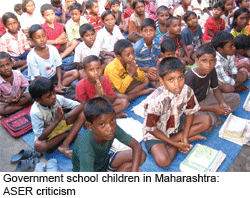Through a low-profile official resolution dated October 18, the Maharashtra state government has created a new office of Commissioner of Education (EC) to oversee the work of eight educational direct-orates, four of which are autonomous. S. Chockalingam (IAS), Inspector General of Registration & Controller of Stamps, took additional charge as EC on October 22. In effect the new EC will head and supervise the entire operations of the department of school education within the education ministry. Chockalingam will report to the additional chief secretary of education and monitor the implementation of all Union and state government school programmes including implementation of the Right to Education (RTE) Act, 2009, the free primary schools mid-day meal scheme and introduction of new student-centric schemes to improve the quality of K-12 education in Maha-rashtra (pop.112 million).
Prior to this development, the state government’s education ministry was administered through eight directors (all non-IAS officers) heading the direcorates of primary, secondary and higher secondary, and adult education; Maharashtra State Council of Education Research and Training (MSCERT); Maharashtra State Board of Secondary and Higher Secondary Education (MSBSHSE); Maharashtra State Bureau of Textbook Production and Curriculum Research (aka Balbharati); Balchitravani and Maharashtra State Council of Examination (MSCE) — all based in Pune. However, even as the state government had begun to implement its restructuring plans to ensure that the eight superseded directors, 18 joint directors and 42 deputy directors are “fruitfully employed”, protests are emanating from the disgruntled directorates and officers unions. The October 18 resolution is being criticised as irrational and hasty.
 “It is an absolutely arbitrary decision. We fail to see the need to appoint an IAS officer to coordinate the eight directorates, and abolition of Balchi-travani (Maharashtra State Education Technology Institute). What happens to the directorate (Balchitravani) and the people employed? Is it the government’s case that Balchitravani is redundant? Moreover Chockalingam is already handling two other portfolios, so how effective will this arrangement be?” queries Dyaneshwar Junarkar, presi-dent, Akhil Maharashtra Shikshan Seva Rajapatrit Adhikari Sanghatana, the education wing of Maharashtra State Gazetted Officers Federation.
“It is an absolutely arbitrary decision. We fail to see the need to appoint an IAS officer to coordinate the eight directorates, and abolition of Balchi-travani (Maharashtra State Education Technology Institute). What happens to the directorate (Balchitravani) and the people employed? Is it the government’s case that Balchitravani is redundant? Moreover Chockalingam is already handling two other portfolios, so how effective will this arrangement be?” queries Dyaneshwar Junarkar, presi-dent, Akhil Maharashtra Shikshan Seva Rajapatrit Adhikari Sanghatana, the education wing of Maharashtra State Gazetted Officers Federation.
Quite obviously the intent behind this restructuring exercise — widely regarded by the state government’s adminis-trative service as an IAS conspiracy — is to coordinate the disparate activities of the autonomous directorates doing their own thing to little effect. Despite its reputation as India’s most indus-trially developed state, Maharashtra is ranked #17 on the EDI (Education Development Index) of the Delhi-based NUEPA. Moreover, the Annual Status of Education Report (ASER) 2013, published by the globally respected Mumbai-based NGO, Pratham, makes several highly critical remarks about the quality of primary education dispensed in rural Maharashtra. The EC appoint-ment is the response of the shaky Congress-NCP government of the state.
Fittingly, the maximum impact of the restructuring exercise has descended on Balchitravani (estb. 1984) which has little to show for its 28 years of efforts to introduce new ICT (information and communication technologies) into Maharashtra’s 67,718 government schools. According to some reports, only 3,000 of 20,000 government and aided secondary schools in the state are ready with computer laboratories for the proposed ICT paper to be introduced in the Secondary School Certificate (SSC) examination of March 2014.
Yet at bottom, the fundamental problem of the state government is the poor quality of manpower — especially in the education ministry — ready, willing and able to serve with it. The ministry’s bureaucrats are recruited by the Maharashtra Public Service Comm-ission (MPSC). However, according to MPSC sources, the quality of recruits — including top-level bureaucrats drawn from the state’s Maharashtra Adminis-trative Service — is “uniformly disapp-ointing”. “The type of youth who apply for these jobs are typically clerical mindset individuals, ironically produced by the state’s sub-standard education system in which even private higher education colleges are run by rustic politicians who know little about qualitative education,” says an MPSC official, speaking on condition of anonymity.
In the circumstances, the appointment of an IAS commissioner to sort out the mess in the state’s education ministry needs to be viewed as a necessary step forward toward reform.
Sunayana Nair (Mumbai)